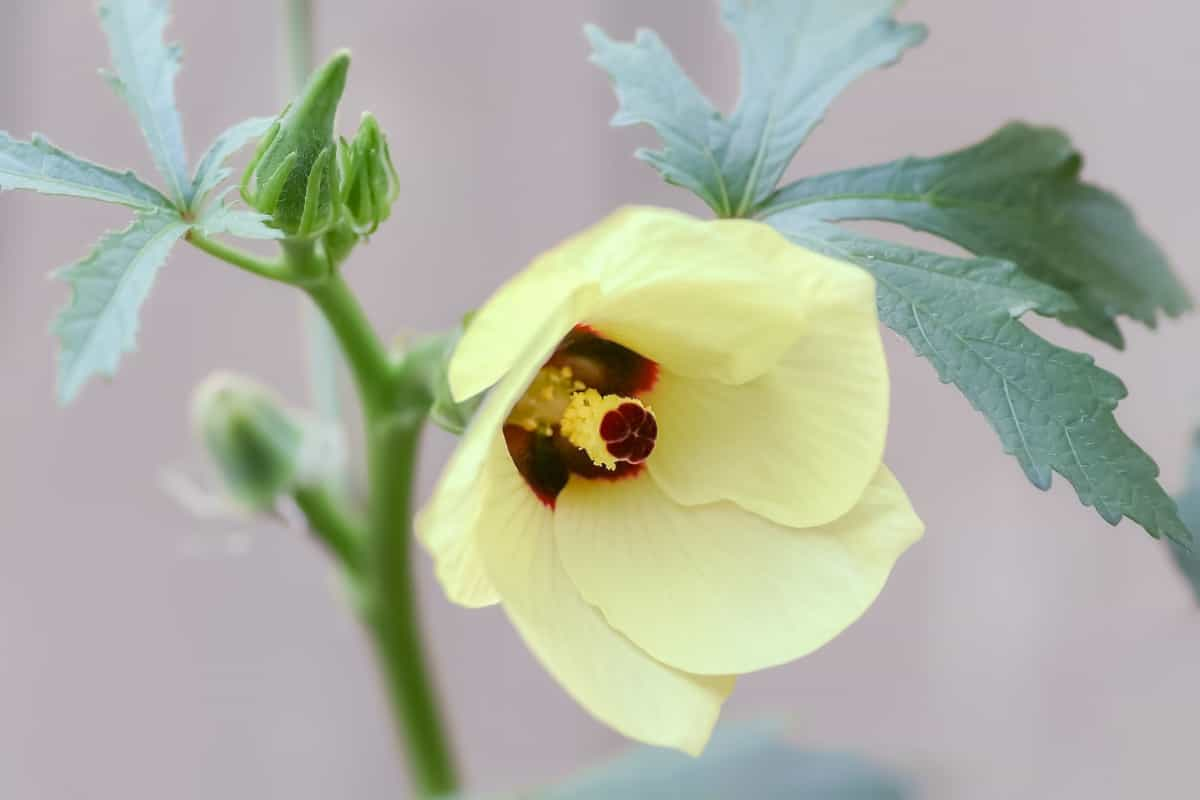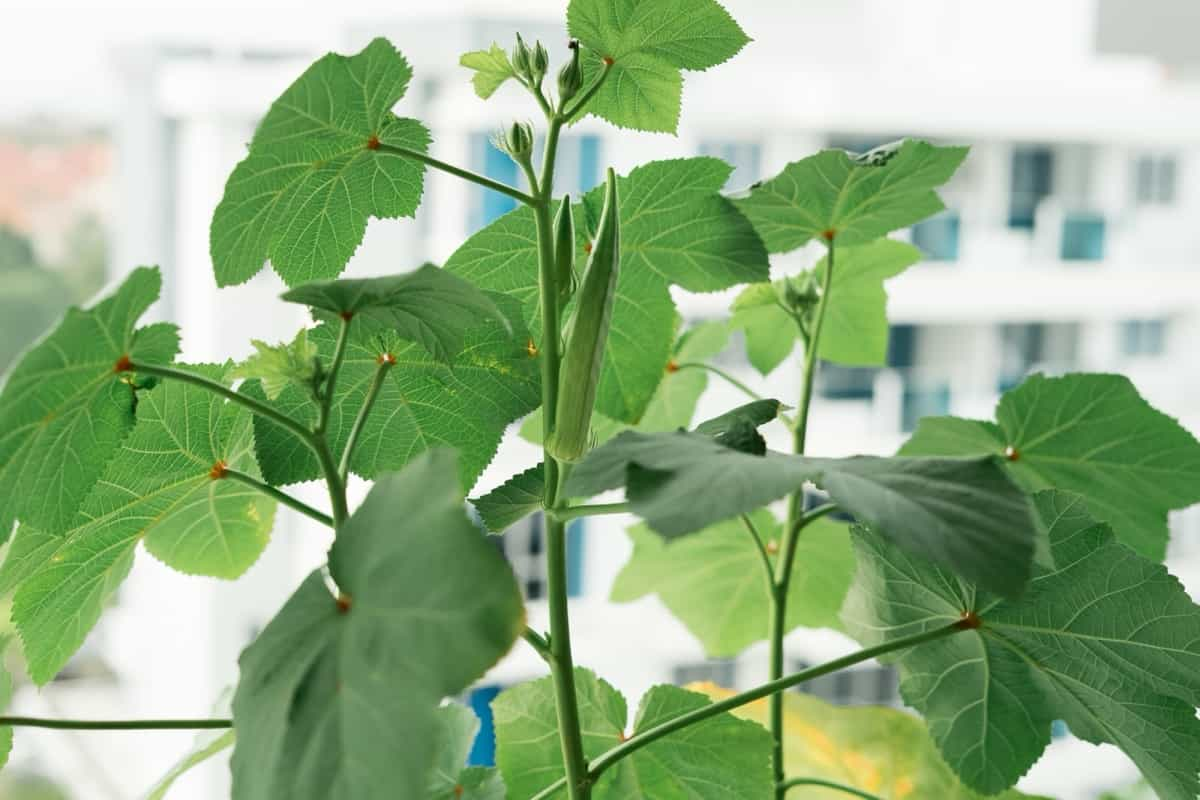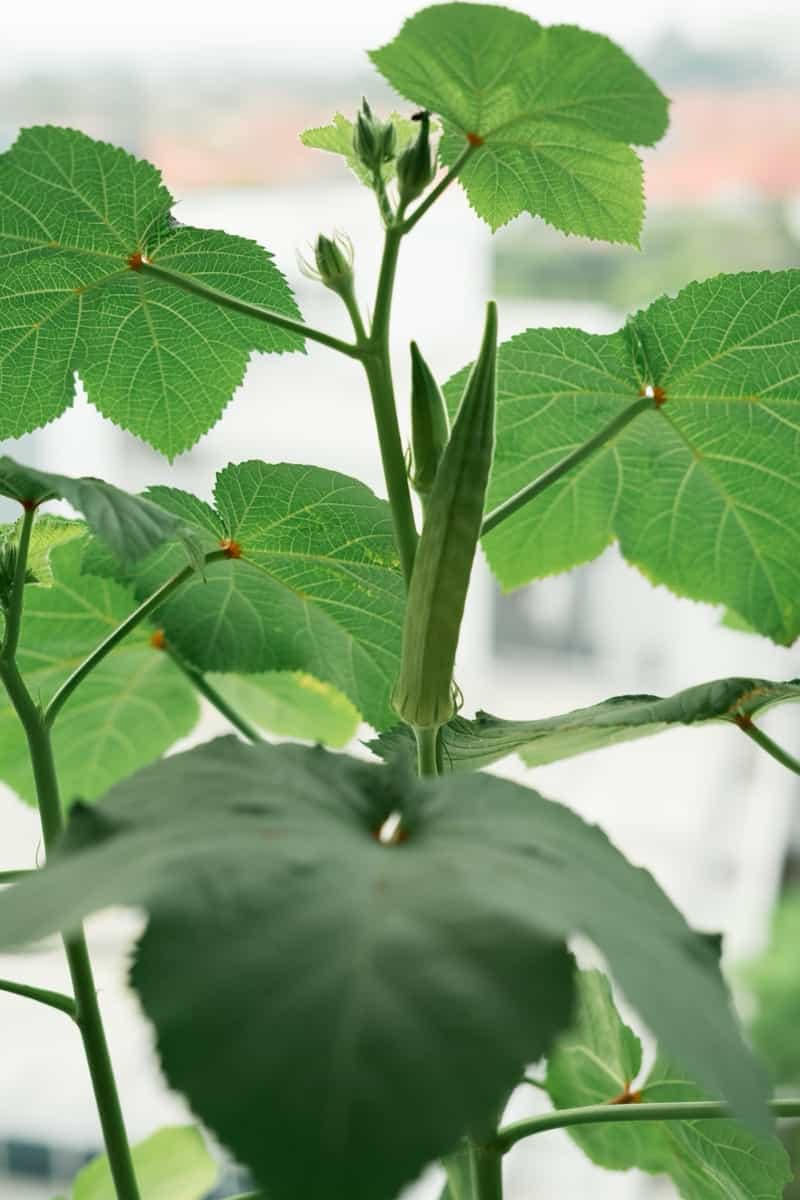Okra is a warm-season vegetable that belongs to the mallow family. It is cultivated in tropical and subtropical areas for its edible green pods. It is a common fungal disease that can significantly impact Okra plants. When powdery mildew infects Okra, it appears as a white or grayish powdery coating on the stems, pods, and leaves. Homemade remedies from natural ingredients like neem oil or baking soda can control Powdery Mildew in Okra plants.

How to Control Okra Powdery Mildew Naturally
Okra Powdery Mildew Causes, Symptoms, and Impact
The main cause of powdery mildew on Okra is poor air circulation. When plants are crowded together or located in an area with little airflow, it creates an excellent environment for the fungus to grow and spread. Symptoms of powdery mildew on Okra usually start as small white spots on the leaves. As the disease progresses, these spots can merge, forming a powdery white coating on the entire leaf surface.
Infected leaves may also become distorted or develop yellow patches. The impact of powdery mildew on Okra can be detrimental if left unchecked. The fungus hampers photosynthesis by covering the leaf surface, which leads to reduced plant growth and lower yields. Severe infections can cause premature defoliation and weaken the plant’s overall health. To effectively manage this fungal disease, it’s crucial to identify early signs of infection and take immediate action.
Identifying the Early Signs of Okra Powdery Mildew
Keep an eye on your Okra plants. Look closely at both sides of the leaves for any white or grayish powder-like substance. This powdery residue is a surefire sign that powdery mildew has taken hold. Another sign of Okra powdery mildew is distorted growth and stunted development. If your Okra plants are not growing as they should or their leaves appear misshapen, it’s time to investigate further.
Powdery mildew can give off a distinct odor that differs from normal plant smells. Don’t forget about leaf discoloration. Yellowing or browning spots on the leaves can also indicate the presence of powdery mildew. You can take action before affecting the plant by staying vigilant and regularly inspecting your Okra plants for these subtle signs.
Cultural Practices to Prevent Okra Powdery Mildew
Rotate Crops: Crop rotation is an effective cultural practice to prevent Okra powdery mildew. Avoid planting Okra in the same spot year after year, as this can increase the risk of powdery mildew. Instead, rotate your crops every season to disrupt disease cycles.
In case you missed it: How to Control Okra Leafhoppers Naturally: How to Get Rid of Them with Natural and Organic Treatment

Proper Spacing: Adequate spacing between Okra plants prevents powdery mildew. Providing enough space allows for better air circulation, which reduces humidity and prevents fungal growth. Aim for a distance of at least 3 feet between plants.
Weed Control: Keep your Okra garden free from weeds that can harbor and spread diseases like powdery mildew. Regularly remove any weeds around your Okra plants to maintain airflow and reduce moisture levels.
Enhancing Air Circulation in the Okra Garden
Good airflow helps to minimize the conditions that favor the growth and spread of this fungal disease. To enhance air circulation, start by spacing out your Okra plants properly. Plant them at a distance that allows for adequate airflow around each plant. Remove any overcrowded or overlapping branches and leaves, as these can create pockets where stagnant air can accumulate. Pruning also helps open the canopy, allowing more sunlight to reach all plant parts and promote drying.
Proper Watering Techniques for Okra Plants
It’s essential to water the plants at their base rather than overhead. This helps prevent moisture lingering on the leaves, creating a favorable environment for powdery mildew. Use a drip irrigation system to deliver water to the plant roots. Furthermore, it’s best to water in the morning when temperatures are cooler. This allows time for any excess moisture on foliage to evaporate before nightfall when conditions become more conducive for fungal growth.
Organic Fungicides for Controlling Okra Powdery Mildew
Organic fungicides offer a natural solution for controlling powdery mildew on Okra plants. The popular organic fungicide is neem oil, derived from the seeds of the neem tree. Neem oil acts as a preventative treatment for powdery mildew. Another organic option is potassium bicarbonate, which alters the pH levels on plant surfaces to create an inhospitable environment for powdery mildew. Spraying a potassium bicarbonate solution directly onto affected leaves can help control and prevent further spread of the disease. Sulfur-based fungicides are also effective against powdery mildew.
Homemade Remedies for Treating Okra Powdery Mildew
- Baking soda – Combine baking soda (one tablespoon) with water (one gallon) and spray it onto the affected leaves. This solution alters the pH level on the leaf surface, making it less favorable for powdery mildew to thrive.
- Garlic – It is another fantastic natural fungicide that can be used against powdery mildew. Crush garlic cloves with water before applying the solution directly to your Okra plants.
Beneficial Insects and Natural Predators for Okra Powdery Mildew Control
Ladybugs, also known as lady beetles, are one of the most well-known beneficial insects for gardeners. They feast on aphids and other soft-bodied pests that can spread powdery mildew. Lacewings are another valuable ally in the battle against this fungal disease. Their voracious appetite for aphids helps keep them in check.
In case you missed it: How to Control Okra Fungal Diseases Naturally: How to Get Rid of Them with Natural and Organic Treatment

Parasitic wasps are like stealth bombers when combating powdery mildew-infected leaves. These wasps lay their eggs inside the aphids or whiteflies’ bodies, eliminating these pests from your garden. Creating an inviting environment for these beneficial insects is essential. Planting flowers such as marigolds and calendula will attract ladybugs and other pollinators to your garden.
Companion Planting Strategies to Minimize Okra Powdery Mildew
- Marigold – Marigolds emit a strong scent that repels pests, including the powdery mildew spores. Planting marigolds around your Okra adds vibrant color to your garden and acts as a natural barrier against this fungal disease.
- Basil – The aromatic oils released by basil plants can help deter powdery mildew from taking hold of your precious Okra plants. Plus, having fresh basil on hand for culinary purposes is a bonus.
- Nasturtiums – Nasturtiums are also great companions for Okra. These beautiful flowers attract aphids away from the delicate leaves of Okra, reducing their vulnerability to powdery mildew infestation.
Pruning Techniques to Manage Okra Powdery Mildew
Removing infected leaves and branches can prevent the disease and save your Okra crop. Inspect your plants for signs of infection when pruning to manage Okra Powdery Mildew. Look for white powdery patches on the leaves, stems, and pods. Once you’ve identified infected areas, carefully remove them with clean pruning shears or scissors.
It’s important to prune infected parts as soon as possible to prevent the spread of spores. Remember to sanitize your tools between cuts by wiping them with rubbing alcohol or bleach. In addition to removing infected areas, consider thinning out dense foliage to improve air circulation around the plants.
Long-term Prevention and Management of Okra Powdery Mildew
- Crop rotation: Avoid planting Okra in the same location year after year, as this can increase the risk of disease buildup in the soil. Rotate with unrelated crops to disrupt disease cycles.
- Sanitation practices: Remove and destroy any infected plant debris from the garden area to minimize overwintering spores. This will help reduce the chances of re-infection in subsequent seasons.
- Resistant varieties: Selecting resistant Okra varieties can be an effective long-term approach to managing powdery mildew. Look for cultivars specifically bred for resistance or tolerance to this fungal disease.
Frequently Asked Questions on Control Powdery Mildew Naturally
Are There Any Cultural Practices That Can Help Prevent Powdery Mildew on Okra?
Yes. To prevent powdery mildew, ensure proper air circulation in your garden by adequately spacing out your Okra plants. Avoid overhead watering the plant, as this can create an ideal environment for fungal growth. Instead, water at the base of the plants using a drip irrigation system.
How Does Powdery Mildew Spread?
This fungus spreads through airborne spores that land on susceptible plant surfaces and germinate under favorable conditions.
In case you missed it: How to Control Lavender Pests Naturally: How to Get Rid of Them with Natural and Organic Treatment

Will Pruning Help Control Powdery Mildew?
Pruning infected plant parts can help reduce the severity of an outbreak but won’t cure existing infections entirely. Focus on removing heavily infected leaves or branches using sharp pruners sterilized between cuts with rubbing alcohol.
What Can I Use to Prevent Powdery Mildew?
You can create your spray using ingredients like baking soda mixed with water or milk diluted with water. These homemade remedies have been known to suppress fungal growth.
Conclusion
The powdery mildew can weaken the plant’s health and vigor, leading to stunted growth and reduced yield. It can also interfere with photosynthesis, hindering the plant’s ability to produce energy from sunlight. As a result, infected Okra plants may experience decreased fruit production and poor-quality harvest. Preventing or managing Okra fungal disease effectively requires careful attention to cultural practices, such as enhancing air circulation around plants through proper spacing and pruning techniques.
- Deworming Schedule for Dogs/Puppies: A Beginners Guide
- How to Prevent and Control Parasites in Goats
- Beneficial Insects in Pest Management
- Natural Solutions for Pest Control in Flower Gardens
- Types of Fungicides Used in Agriculture
- Common Issues in the Fruit Development Stage of Pomegranate Farming
- Fruit Development Issues in Papaya: Easy Solutions and Treatment
- Soil-Borne Diseases and How to Protect Your Plants
- Practices to Prevent Disease Spread in the Garden